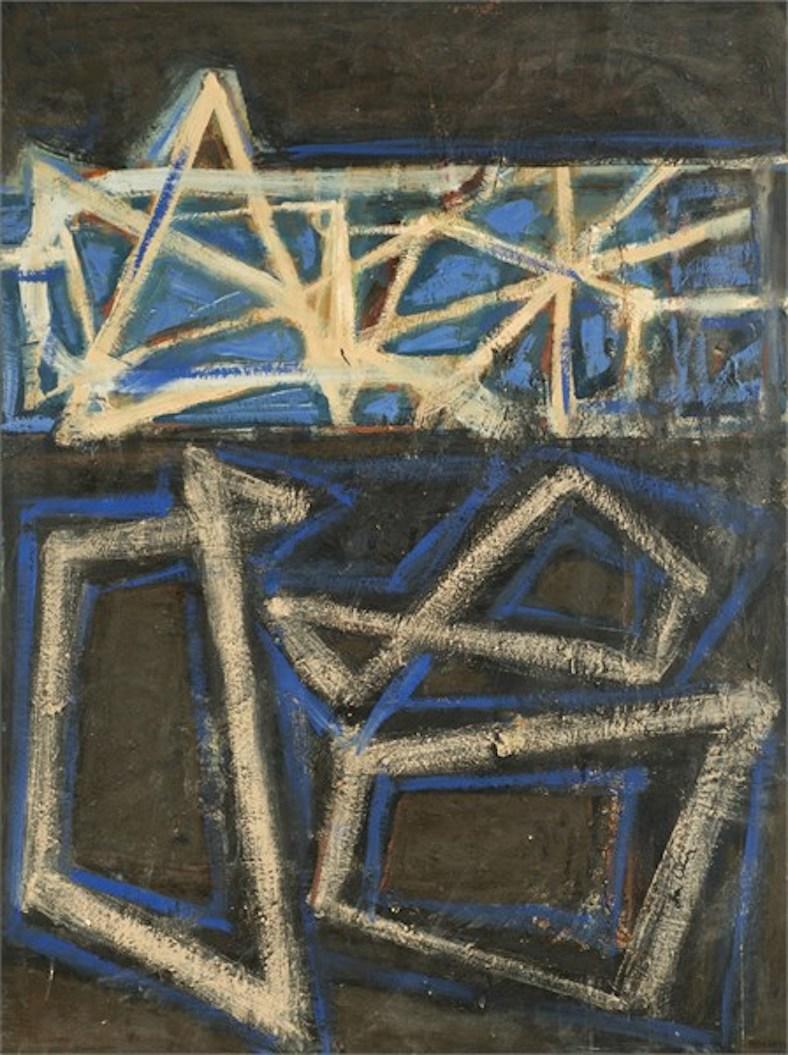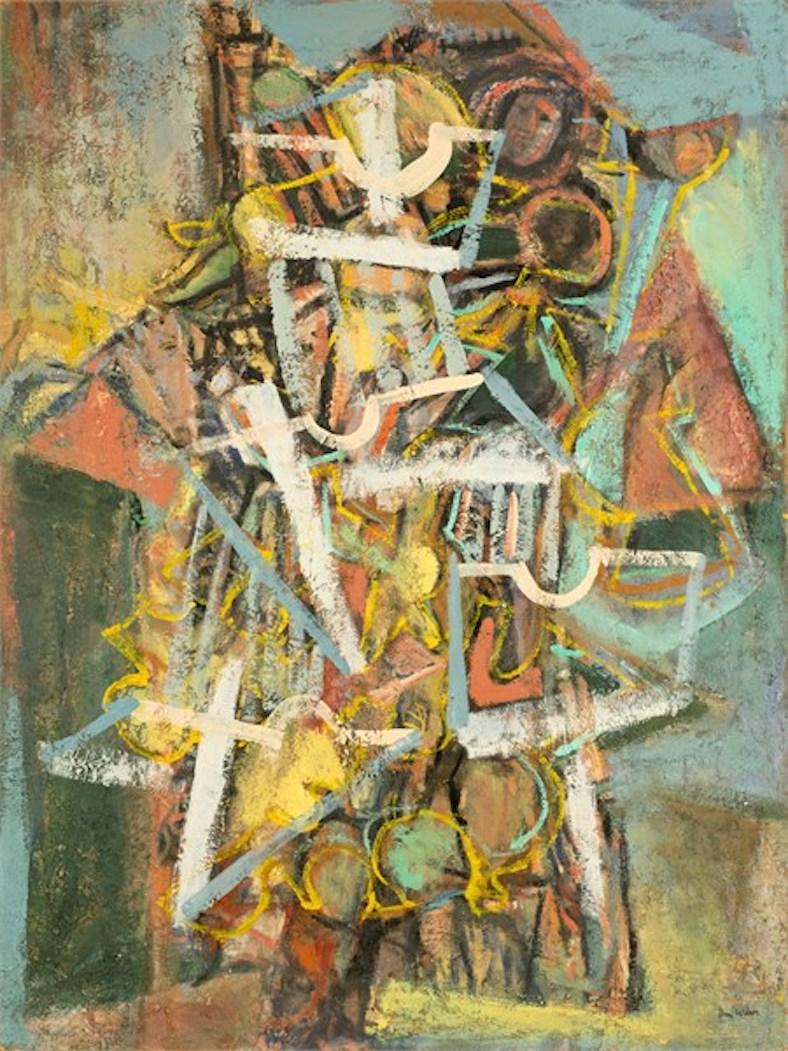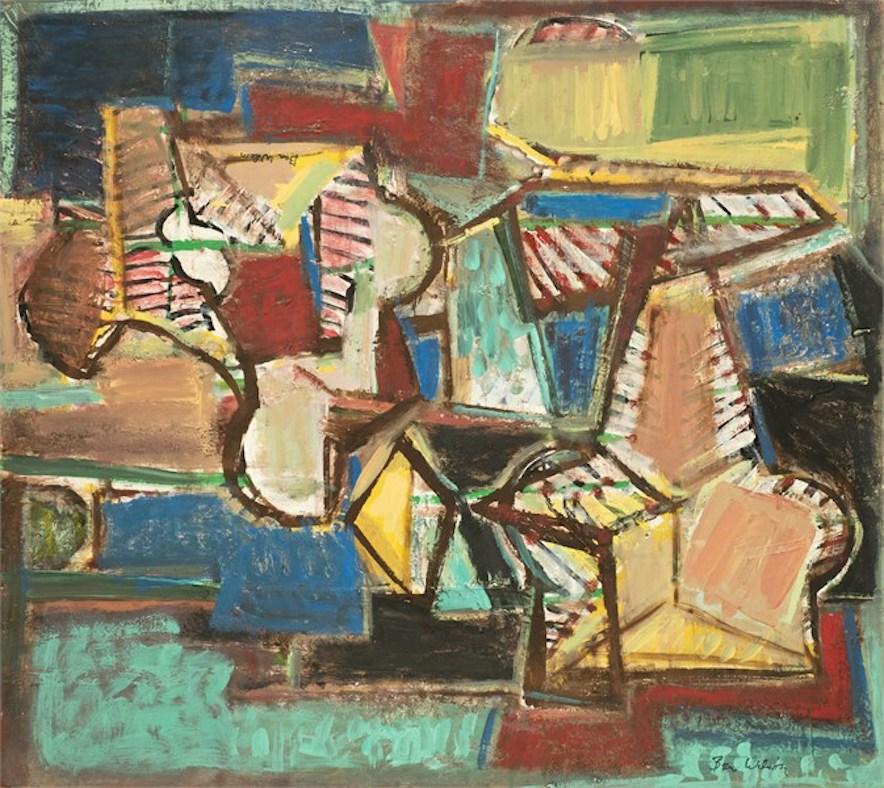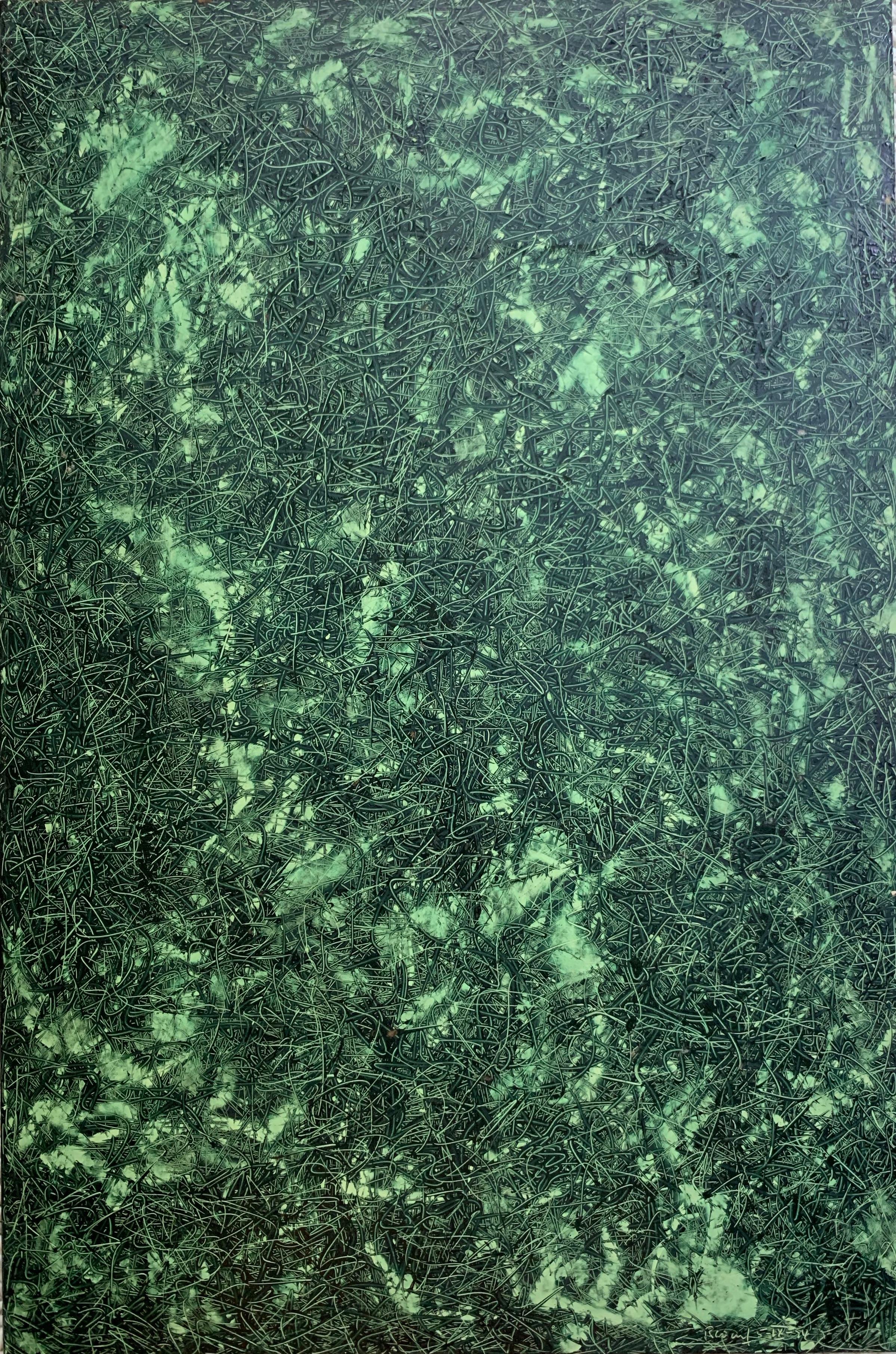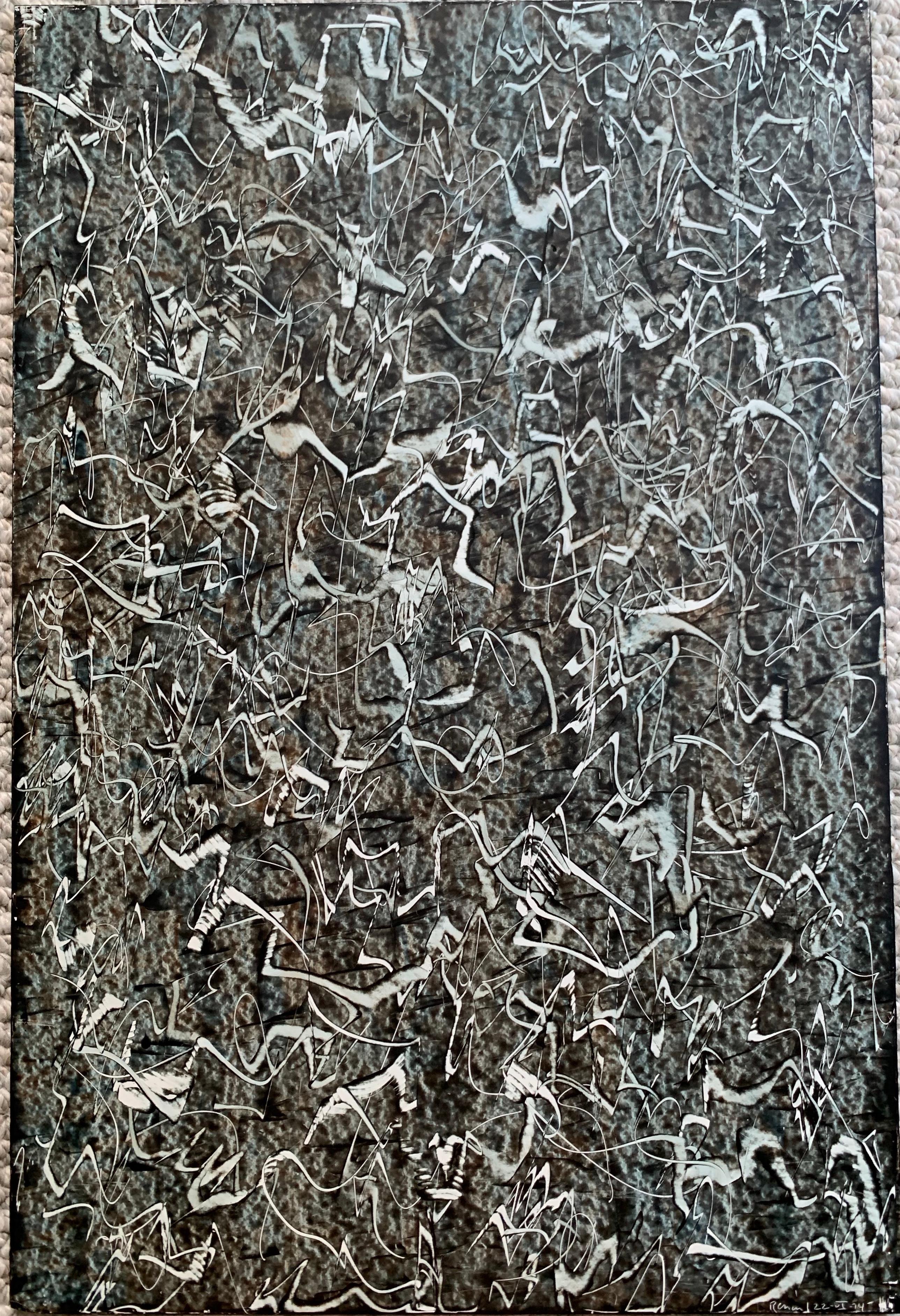Items Similar to Bold German American Abstract Expressionist Color Field Oil Painting Carl Holty
Want more images or videos?
Request additional images or videos from the seller
Carl HoltyBold German American Abstract Expressionist Color Field Oil Painting Carl Holty
About the Item
Carl Robert Holty (American 1900-1973)
Abstract Expressionism Oil on Masonite board.
Abstract with greens blues and red,
Dimensions 12 x 9-1/2 inches. Framed 17 X 14 inches
Hand signed faintly in ink lower left Holty.
Provenance: Richard Norton Gallery (bears label verso)
Carl Robert Holty (1900–1973) was a German-born American abstract painter. Raised in Wisconsin, he was the first major abstract painter to gain notoriety from the state. Harold Rosenberg described Holty as "a figure of our art history," known for his use of color, shape and form.
Carl Holty was born in 1900 in Freiburg, Germany. Shortly after his birth, the family moved to Milwaukee, Wisconsin, where they lived in the German district with his grandparents. The Holty family then moved to the countryside near Green Bay where his father practiced medicine, before returning to Milwaukee around 1906. Holty's grandfather introduced him to art by taking him to visit local art galleries. Around the age of twelve, Holty began taking lessons with a local German painter. As a teenager, he started drawing cartoons and became interested in poster art. He attended Milwaukee University School, graduating high school within two and a half years. In 1919 he went to Marquette University, then joining the Reserve Officers' Training Corps during World War I, with the program ending within the same year. He enrolled at the Art Institute of Chicago, eventually attending classes at the Parsons School of Design. He returned to Milwaukee in 1923 and opened a portrait painting studio.
In 1925 Holty married and honeymooned in Europe, living there for the next ten years, first in Munich and then Switzerland. He moved to Paris that year, before returning to the United States in 1935 and living in New York City. He taught at Brooklyn College from 1950 until 1970. During that time he also was a visiting instructor at the Art Students League, Washington University in St. Louis, and University of Louisville. Upon his retirement from Brooklyn College he was awarded the title of professor emeritus.
In 1926, while living in Munich, Holty originally planned to attend the Royal Academy, only to train under Hans Hofmann. Hofmann's ideas about space, color, and shape would transform Holty's work, with Holty's work becoming more abstract as time went on.
From 1930 to 1935 he lived in Paris, exhibiting his work to good reception. There he met Robert Delaunay and Sonia Delaunay and joined Delaunay's group Abstraction-Création. His work was published in the group's magazine and became associated with Cubism and Neo-Plasticism. His Paris works have been compared to the paintings of Juan Gris and the synthetic Cubism of Pablo Picasso.
Upon returning to the United States, he found artist representation in New York City and became involved, once again, with Hans Hofmann and Vaclav Vytlacil as well as Stuart Davis, whom he had known in Paris. Vytlacil invited Holty to participate in discussions which led to the formation of the American Abstract Artists, which Holty would eventually come to chair, retaining his membership until 1944. During this time, he moved away from Cubism and started to experiment with Biomorphism. In the 1930s he used tape to give strong edges to forms, also reworking and overpainting sections, as seen in his work Gridiron (1943–1944). Between 1945 and 1948 he was represented by the Samuel M. Kootz Gallery. He continued to explore shapes and form, and by the 1960s contours had disappeared from his work, being replaced with subtle toned-down colors.
Holty served as artist in residence at Georgia State University, University of Florida, University of California at Berkeley, University of Wisconsin and the Corcoran School of Art. He also wrote a book, with Romare Bearden, titled The Painter's Mind, published in 1969.
In 1977 the Carl Holty Papers were donated to the Archives of American Art by Charles Byrne. On his role as a Wisconsin artist, Andrew Stevens stated in 1995 that "Holty's zeal for non-objective art was more closely identified with the younger group of American painters in the East. His artworks including his prints are among the first by a Wisconsin artist to come to grips with the tide of abstract art that spread from Europe to America at the beginning of the 20th century."
He was included in the portfolio of lithograph works; Various Artists, American Abstract Artists 1937 with Werner Drewes, Ilya Bolotowsky, Balcomb Greene, Ray Eames, Louis Schanker, Esphyr Slobodkina and Byron Browne.
Notable exhibitions
Carl Holty: The World Seen and Sensed, 1980–81; Milwaukee Art Museum
Annual Exhibition of Contemporary Painting, 1945; Whitney Museum of American Art
American Painting Today, 1950; Metropolitan Museum of Art
Abstract Painting and Sculpture in America, 1951; Museum of Modern Art
(Josef Albers, William Baziotes, Alexander Calder, Willem de Kooning, Philip Guston, Marsden Hartley, Jackson Pollock, Isamu Noguchi and Man Ray.)
Contemporary American Painting and Sculpture, 1963; Krannert Art Museum
- Creator:Carl Holty (1900 - 1973, American)
- Dimensions:Height: 17 in (43.18 cm)Width: 14 in (35.56 cm)
- Medium:
- Movement & Style:
- Period:
- Condition:
- Gallery Location:Surfside, FL
- Reference Number:1stDibs: LU38212877782
Carl Holty
Born in Freiburg, Germany, Carl Holty moved with his parents to a Germain community in Milwaukee when he was an infant. He began studying art at the Milwaukee Normal School under instructors who had trained in Europe and later continued his studies at the Art Institute of Chicago. In 1919, following a summer at an artists' colony in Saugatuck, Michigan, Holty enrolled at Parsons School of Design and the National Academy of Design, both in New York. He briefly considering entering medical school, his father’s profession, though with the help of his grandfather, returned to Germany to continue his art education. It was at Hans Hofman’s school that Holty would be introduced to the principles of modernist composition and ideas in painting and drawing, an influence he would consider his main focus throughout his career. Hofmann "first opened my eyes to the plastic nature of drawing." Holty once recalled. Displaying no interest in the predominant style of expressionism, popular in Germany at the time, Holty focused on the tenants of Cubism, Fauvism, and Futurism which lead him, in 1928, to relocate to Paris. Holty quickly became part of the active artistic community in the nation’s capital associating with many of the major figures of international avant-garde art including Miro, Mondrian, Arp, and Delaunay, the latter of which sponsored Holty to become one of only two American members of the Abstraction-Creation group founded by Theo Van Doesburg. Holty returned to America in 1936 becoming a significant figure in the development of abstract art. He reconnected with his old mentor Hans Hofmann and developed friendships with many of the City’s rising artist’s including Vaclav Vytlacil whom he had known in Paris. It was this group that formed the American Abstract Artists association, where Holty would serve as chairman in 1938 and with whom he’d exhibit with through 1944. It was during this period Holty abandoned Cubism for Biomorphism, leaving behind edges to explore shapes and forms that ultimately lead to his color field paintings of the mid 1950s and through the remainder of his career.
About the Seller
4.9
Platinum Seller
These expertly vetted sellers are 1stDibs' most experienced sellers and are rated highest by our customers.
Established in 1995
1stDibs seller since 2014
1,550 sales on 1stDibs
Typical response time: 1 hour
- ShippingRetrieving quote...Ships From: Surfside, FL
- Return PolicyA return for this item may be initiated within 3 days of delivery.
More From This SellerView All
- American Modernist Abstract Expressionist Oil Painting Carving William PelliconeLocated in Surfside, FLWilliam Pellicone (American 1915-2004) Mixed media, pyrography, oil on wood carving painting. Dated 1958 Title - Enthymeme #14. Oil painting on carved and burnt distressed wood panel. Inscribed verso Enthymeme Wm. Pellicone #14, 9-4-58. Label on reverse with a typed definition for Enthymeme. Dimensions: 27 inches high, 42.5 inches wide. Metal wrap frame. Provenance: from a Shelter Island NY home that was designed by architect Henry J. Gazon - A.I.A. built in 1959. William Pellicone (1915-2004) was an American painter known for his abstract compositions and use of vibrant colors. He was born in New York City and studied at the Art Students League and the Brooklyn Museum Art School. Pellicone's early work was influenced by the Social Realist movement of the 1930s and 1940s, with his paintings often featuring realistic depictions of urban scenes and working-class people. However, in the 1950s he shifted towards abstraction, exploring the interplay of color and form. Pellicone's mature style was characterized by his use of vibrant, saturated colors, often applied in thick layers of paint. His paintings often featured geometric shapes and organic forms, with a strong sense of movement and energy. In addition to his painting, Pellicone was also a respected teacher and arts administrator. He taught at the New York Institute of Technology and the State University of New York, and served as the director of the Islip Art Museum on Long Island. Pellicone's artwork was exhibited widely during his lifetime, and he was the recipient of numerous awards and honors, including a National Endowment for the Arts grant in 1977. Today, his paintings can be found in the collections of museums and galleries around the world, including the Smithsonian American Art Museum in Washington, D.C. and the Metropolitan Museum of Art in New York. William Pellicone (Born 1915) is active/lives in New York. William Pellicone is known for Abstract expressionist, landscape and non-objective art. An American artist, sculptor, architect. He exhibited at Pennsylvania Academy Fine Arts...Category
1950s Abstract Expressionist Abstract Paintings
MaterialsWood, Oil
- Large Modernist French Abstract Expressionist Colorful Bird Painting Roger LersyBy Roger LersyLocated in Surfside, FLRoger Lersy, French (1920 - 2004) Oil on canvas Signed, R. Lersy, dated 1961 lower right Measuring 35 X 31 Matted and framed. sight 26 X 21.5 Roger Lersy was born in Paris, France 1920, in the rough neighborhood surrounding Place Pigalle. His youth was marked by extreme poverty. Lersy studied art and music at the École des Arts Apppliqués. He was a painter, lithographer and musician-composer He belongs to the École de Paris and was a member in the movement of the Young Painting. By 1946, when he first exhibited in Paris, Lersy became one of the founders of the School of Paris’ New Graphic School. Lersy received the Prix des Amateurs d’Art in 1953, the Shell Prize in 1954 and the Grand Prize of the City of Marseilles in 1953. Lersy could be defined as a Baroque expressionist. For Bernard Dorival, Roger Lersy is along with Gabriel Dauchot, Jean Commère and Raymond Guerrier among "the most noted champions of this expressionism which is part of the continuation of Bernard Buffet's miserabilism". Famous works: New Year's Eve , Aubusson tapestry of the Manufacture des Gobelins , Permanent Mission of France to the United Nations , One Dag Hammarskjöld Plaza , New York . Venice , bridges , watercolor, 1963 (theme of the Roger Lersy exhibition, Chicago). The poppy , original lithograph, Imprimerie Bellini, 1978, collection of the Cabinet des estampes , BNF . Still life at the pedestal table , oil on canvas, Jonzac town hall. Lohengrin , oil on canvas, Versailles Administrative Court of Appeal. Portrait of the painter Tony Agostini , drawing. Series Eiffel Tower. Stained glass: Saint-Laurent Church, Longlaville ( Meurthe-et-Moselle ), 29 stained glass windows. Musical works: Stained glasses for clarinet , saxophone, cello and percussion , creation in the church of Longlaville, 1972. Three pieces for two waves Martenot : 1. Scum of dream, 2. Scare and jubilation. Malicious connivance, sheet music Editions A. Leduc, Paris, 1979. Work for trumpet and piano , published by Éditions G. Billaudot, Paris, 1984. Five pieces for piano , scores published by G. Billaudot, Paris, 1989. Five preludes for piano and alto saxophone , scores at Éditions Combre, premiere at Flâneries musicales de Reims , 1993. In memory of Chagall , piece for flute and percussion , recording of Duo Hyksos (Henri Tournier, flute and Michel Gastaud, percussion) in 1995. Preface in black and yellow for horn and piano , score at Éditions Combre, Arc-en-ciel collection, 2000. Soundtracks: Diatomées Note 4 , 19 , film by Jean Painlevé...Category
1960s Abstract Expressionist Abstract Paintings
MaterialsOil, Acrylic, Canvas
- Australian American D. Rankin Abstract Expressionist Oil Painting Rocky HillsideBy David RankinLocated in Surfside, FLDavid Rankin, American (b. 1946) Rocky Hillside, (1990) Oil on paper Hand signed lower right, signed and titled verso. 30 x 22 1/2 inches David Rankin is a New York-based, British-born Australian post-war and contemporary artist known for his expressionistic abstract paintings. His work can be categorized by his use of quick, loose brushstrokes, reminiscent of scribbles on a page. Rankin works predominantly in oil painting and acrylic on canvas, but also works with paper, prints, sculptures and ceramics. Rankin has held over 100 one-person exhibitions in cities across the world, including New York, London, Paris, Beijing, Mexico, Vienna, Berlin and Cologne, as well as all over Australia. Represented in many of the world’s leading public and private collections and museums, David Rankin’s work is featured in Australia’s leading institutions, including the National Gallery of Australia, Art Gallery of New South Wales, National Gallery of Victoria and Queensland Art Gallery. David Rankin was born in Plymouth, Devon, England in 1946 then emigrated to Australia with his family in 1948. He spent his childhood in the 1950s in the semi-rural Port Hacking region South of Sydney and his teenage years in country New South Wales, from Hay, Wagga Wagga and Albury in the South to Bourke and Brewarrina in the North. Rankin is self-taught, developing his techniques and ideas in the outback towns of his youth. He was inspired by the greats from Leonardo da Vinci to Paul Klee as well as being influenced by the history of Buddhism and Asian art. In his travels before he arrived in Sydney in 1967 he developed a concept of what he wanted to achieve as an Australian artist. His dream was to express the anima, the life spirit or the essence of God in all nature. As an Australian artist he believed could bring the elements of Western Art together with an understanding and love for the cultures of Asia and the Australian Aborigine. He also felt that as Australia was closer to Asia than Europe it made sense to think about the art of Indian, Chinese and Japanese artists, and that one could not be an authentic articulate Australian artist without a love and respect for the artistic and spiritual expressions of the various Aboriginal artists, peoples and cultures. His work combined elements of Abstract Expressionist painting with Jewish and Aboriginal influences. In 1979 his first wife, Jennifer Mary Roberts (née Haynes) died. Rankin subsequently met his current wife Lily Brett, whose own life was etched by tragedy with her parents being survivors of the Holocaust. She too migrated to Australia as a child after the Second World War in 1948. The artist recounts that his empathy for Lily and the pity for his first wife's death fused into what he calls "the dark blessing of my life." The darkness was transformed into images. The author Dore Ashton writes that the events of 1979 and the fire which ravished his studio in 1997 and burnt his art works and many personal possessions, had a profound impact on his work. Having personal life experiences as his subject matter, Rankin's paintings contemplate these things. For example, his Jerusalem series followed a trip to Jerusalem in 1988, which then led to his Golgotha works. His travels to the Australian, American and Mexican deserts became the subject matter for many of his canvases, such as Ridge – Mungo, Golden Prophecy – San Antonio, Grey Sonora Landscape and then led to his Witness Series. From the fire in his studio he then painted Buddha and Flames. He illustrated two books by Lily Brett on the holocaust and explored the theme further in his huge work The Drowned and The Saved from a book by Primo Levi of the same name. Through Brett he encountered Jewish mythology and painted judaica imagery, Black...Category
1990s Abstract Expressionist Abstract Paintings
MaterialsPaper, Oil
- Signed Castro Abstract Expressionist 1960s Latin American Oil Painting CollageLocated in Surfside, FL'La Multitud Sodomita Rodea la Casa de Lot' Titled and signed in Spanish. it refers to the biblical story of Lot with the Sodomites. It is a very well executed piece signed Castro an...Category
1960s Abstract Expressionist Abstract Paintings
MaterialsMixed Media, Oil
- French Gestural Abstract Expressionist Textured Oil PaintingBy Rene CouturierLocated in Surfside, FLRene Couturier lives in the Netherlands and France. Rene Couturier is known for abstract still life, figure and landscape painting. Rene' Couturier is an artist whose works displays...Category
1970s Abstract Expressionist Abstract Paintings
MaterialsCanvas, Oil
- Abstract Composition with Heart Jay Milder Rhino Horn Oil PaintingBy Jay MilderLocated in Surfside, FLJay Milder (born 1934) is an American artist and a figurative expressionist painter of the second generation New York School. Old Testament themes such as Jacob's Ladder and Noah’s Ark, and the Jewish mystical beliefs of the Kabbalah, are recurring themes in Milder’s paintings which are presented as archetypal images that recur in the basic karma, make-up and need of human nature. Internationally exhibited, Milder is included in the collections of many national and international museums. He has been the subject of two, recent retrospectives in Brazil in 2007 at the National Museum Brasilia and, in 2006, at the Museum of Modern Art, in Rio de Janeiro. He is renowned in Sao Paulo, one of the major international centers for street and public art, as a seminal influence on graffiti artists. Jay Milder was born in Omaha, Nebraska, in 1934. His grandparents, who came from the Ukraine, were descendants of the Hasidic mystic, Rabbi Nachman. As he listened to family stories his interest in spiritualism and mysticism increased, and became an important influence on his philosophy of life and art. Later, when he arrived in New York, he was drawn to the Theosophical Society and the teaching of Helena Blavatsky. In 1954 Milder visited Europe where he studied painting with André L’Hote, and sculpture with Ossip Zadkine. He spent much time studying at the Louvre Museum, and at the studio of Stanley Hayter. During his Paris years the paintings of the Jewish painter Chaim Soutine, primarily influenced him. Milder returned to the United States in 1956, and he began studying painting at the Chicago Art Institute. He exhibited with the Momentum Group, an alliance of artists who were particularly dedicated to the progression of figurative art and its global origins. In 1957, Milder spent the summer in Mexico for a summer where he exhibited in Puebla. That year he received the Mexican Government’s Honor Award for artists. In the summer of 1958, Milder studied with Hans Hofmann in Provincetown, Massachusetts. He exhibited his work at the Sun Gallery, with his contemporaries, including Mary Frank, Red Grooms, Bob Thompson...Category
20th Century Abstract Expressionist Abstract Paintings
MaterialsOil
You May Also Like
- Chartres, 1989By Ben WilsonLocated in Quogue, NYBorn in Philadelphia, Ben Wilson was a New York abstract expressionist painter. His work was exhibited frequently from the mid-thirties through sixties, and less frequently but consi...Category
1980s Abstract Expressionist Abstract Paintings
MaterialsMasonite, Oil
- Untitled, 55By Ben WilsonLocated in Quogue, NYBorn in Philadelphia, Ben Wilson was a New York abstract expressionist painter. His work was exhibited frequently from the mid-thirties through sixties, and less frequently but consi...Category
1960s Abstract Expressionist Abstract Paintings
MaterialsMasonite, Oil
- Untitled, 87By Ben WilsonLocated in Quogue, NYBorn in Philadelphia, Ben Wilson was a New York abstract expressionist painter. His work was exhibited frequently from the mid-thirties through sixties, and less frequently but consi...Category
1960s Abstract Expressionist Abstract Paintings
MaterialsMasonite, Oil
- Untitled (ER39) Abstract Expressionist paintingLocated in Wilton Manors, FLEdward Pechmann Renouf (1906-1999). Oil on panel measures 16 x 24 inches. Signed lower margin. Excellent condition. Provenance: Allan Stone Pr...Category
1970s Abstract Expressionist Abstract Paintings
MaterialsMasonite, Oil
- Untitled (ER41) Abstract Expressionist paintingLocated in Wilton Manors, FLEdward Pechmann Renouf (1906-1999). Oil on panel measures 16 x 24 inches. Signed lower margin. Excellent condition. Provenance: Allan Stone Pr...Category
1970s Abstract Expressionist Abstract Paintings
MaterialsMasonite, Oil
- Untitled (ER44) Abstract Expressionist paintingLocated in Wilton Manors, FLEdward Pechmann Renouf (1906-1999). Oil on panel measures 16 x 24 inches. Signed lower margin. Excellent condition. Provenance: Allan Stone Pr...Category
1970s Abstract Expressionist Abstract Paintings
MaterialsMasonite, Oil
Recently Viewed
View AllMore Ways To Browse
Hartley Green
German World War 2
Vintage Philips Poster
Vintage Posters Berkeley
Noguchi Time
Esphyr Slobodkina
Vintage Milwaukee Poster
Vintage Milwaukee Posters
Vintage Oil Field Signs
Juan Josef
Vintage Plastic Bear
World War 1 German Expressionist
American 1960s Paintings
Edward Dugmore
Art Cryptography
Bob Arrigo
Gary Johns Symbol
Giuseppe Zumbolo
